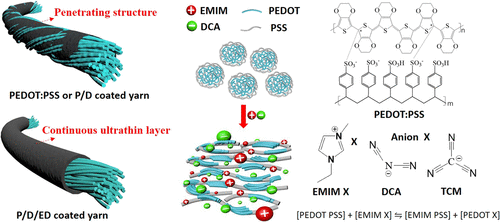当前位置:
X-MOL 学术
›
ACS Appl. Mater. Interfaces
›
论文详情
Our official English website, www.x-mol.net, welcomes your feedback! (Note: you will need to create a separate account there.)
Synergistically Improving Flexibility and Thermoelectric Performance of Composite Yarn by Continuous Ultrathin PEDOT:PSS/DMSO/Ionic Liquid Coating
ACS Applied Materials & Interfaces ( IF 9.5 ) Pub Date : 2021-10-14 , DOI: 10.1021/acsami.1c15946 Mufang Li 1 , Fanjia Zeng 1 , Mengying Luo 1 , Xing Qing 1 , Wen Wang 1 , Ying Lu 1 , Weibing Zhong 1 , Liyan Yang 1 , Qiongzhen Liu 1 , Yuedan Wang 1 , Jie Luo 2 , Dong Wang 1
ACS Applied Materials & Interfaces ( IF 9.5 ) Pub Date : 2021-10-14 , DOI: 10.1021/acsami.1c15946 Mufang Li 1 , Fanjia Zeng 1 , Mengying Luo 1 , Xing Qing 1 , Wen Wang 1 , Ying Lu 1 , Weibing Zhong 1 , Liyan Yang 1 , Qiongzhen Liu 1 , Yuedan Wang 1 , Jie Luo 2 , Dong Wang 1
Affiliation

|
Combining fabrics with a poly(3,4-ethylenedioxythiophene):poly(styrenesulfonate) (PEDOT:PSS) coating is the most promising method to fabricate wearable thermoelectric (TE) devices. However, the high modulus, low strain, and low TE performance of PEDOT:PSS coating lead to poor flexibility and low power generation efficiency. In this study, dimethyl sulfoxide (DMSO) and ionic liquids (ILs) were selected as a modifier to enhance the flexibility and TE performance of PEDOT:PSS. Different from the penetrating structure and coil conformation of pristine PEDOT:PSS coating, a flexible continuous ultrathin layer of PEDOT:PSS/DMSO/1-ethyl-3-methylimidazolium dicyanamide (P/D/ED) with a linear conformation forms on the surface of cotton yarn. The morphology and structure of PEDOT:PSS and P/D/ED coating were characterized by FESEM, XPS, and Raman spectroscopy. Compared with the pristine PEDOT:PSS film, the P/D/ED film shows significantly reduced modules and enhanced strain and bending stability. Moreover, the TE performance of P/D/ED-coated yarn is significantly enhanced with nearly half mass loading. Based on this, a large-area wearable TE fabric with enhanced flexibility and TE performance was prepared. The output power density is 136.1 mW/m2 at ΔT = 40.8 K, which is a typically high value compared with the former reported composite TE fabrics. This study provides a new way to synergistically enhance the flexibility and TE performance of composite yarn, and the prepared TE fabric has great potential as a wearable power source.
中文翻译:

通过连续超薄 PEDOT:PSS/DMSO/离子液体涂层协同提高复合纱线的柔韧性和热电性能
将织物与聚(3,4-亚乙基二氧噻吩):聚(苯乙烯磺酸盐)(PEDOT:PSS)涂层相结合是制造可穿戴热电(TE)设备的最有前途的方法。然而,PEDOT:PSS涂层的高模量、低应变和低TE性能导致柔韧性差和发电效率低。在本研究中,选择二甲基亚砜 (DMSO) 和离子液体 (IL) 作为改性剂,以提高 PEDOT:PSS 的柔韧性和 TE 性能。与原始PEDOT:PSS涂层的穿透结构和线圈构象不同,在表面形成具有线性构象的PEDOT:PSS/DMSO/1-乙基-3-甲基咪唑鎓二氰胺(P/D/ED)的柔性连续超薄层棉纱。PEDOT:PSS 和 P/D/ED 涂层的形貌和结构通过 FESEM、XPS 和拉曼光谱表征。与原始 PEDOT:PSS 薄膜相比,P/D/ED 薄膜显示出显着减少的模块和增强的应变和弯曲稳定性。此外,P/D/ED 涂层纱线的 TE 性能在接近一半的质量负载时显着增强。在此基础上,制备了一种具有增强柔韧性和热电性能的大面积可穿戴热电织物。输出功率密度为 136.1 mW/m2 at Δ T = 40.8 K,与之前报道的复合 TE 织物相比,这是一个典型的高值。该研究为协同增强复合纱线的柔韧性和热电性能提供了一种新方法,所制备的热电织物作为可穿戴电源具有巨大的潜力。
更新日期:2021-10-27
中文翻译:

通过连续超薄 PEDOT:PSS/DMSO/离子液体涂层协同提高复合纱线的柔韧性和热电性能
将织物与聚(3,4-亚乙基二氧噻吩):聚(苯乙烯磺酸盐)(PEDOT:PSS)涂层相结合是制造可穿戴热电(TE)设备的最有前途的方法。然而,PEDOT:PSS涂层的高模量、低应变和低TE性能导致柔韧性差和发电效率低。在本研究中,选择二甲基亚砜 (DMSO) 和离子液体 (IL) 作为改性剂,以提高 PEDOT:PSS 的柔韧性和 TE 性能。与原始PEDOT:PSS涂层的穿透结构和线圈构象不同,在表面形成具有线性构象的PEDOT:PSS/DMSO/1-乙基-3-甲基咪唑鎓二氰胺(P/D/ED)的柔性连续超薄层棉纱。PEDOT:PSS 和 P/D/ED 涂层的形貌和结构通过 FESEM、XPS 和拉曼光谱表征。与原始 PEDOT:PSS 薄膜相比,P/D/ED 薄膜显示出显着减少的模块和增强的应变和弯曲稳定性。此外,P/D/ED 涂层纱线的 TE 性能在接近一半的质量负载时显着增强。在此基础上,制备了一种具有增强柔韧性和热电性能的大面积可穿戴热电织物。输出功率密度为 136.1 mW/m2 at Δ T = 40.8 K,与之前报道的复合 TE 织物相比,这是一个典型的高值。该研究为协同增强复合纱线的柔韧性和热电性能提供了一种新方法,所制备的热电织物作为可穿戴电源具有巨大的潜力。



























 京公网安备 11010802027423号
京公网安备 11010802027423号